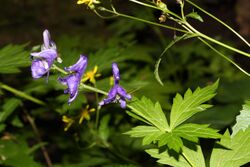Biology:Aconitum columbianum
| Aconitum columbianum | |
|---|---|

| |
| Aconitum columbianum in Mount Baker-Snoqualmie National Forest | |
| Scientific classification | |
| Kingdom: | Plantae |
| Clade: | Tracheophytes |
| Clade: | Angiosperms |
| Clade: | Eudicots |
| Order: | Ranunculales |
| Family: | Ranunculaceae |
| Genus: | Aconitum |
| Species: | A. columbianum
|
| Binomial name | |
| Aconitum columbianum | |

| |
| Synonyms | |
|
Aconitum geranioides | |
Aconitum columbianum is a species of flowering plant in the buttercup family known by the common names Columbian monkshood or western monkshood.
This wildflower is native to western North America where it grows in riparian and other moist areas, in meadows and coniferous forests. It is found from 600–2,900 metres (2,000–9,500 ft) in elevation.[1]
Description
Aconitum columbianum is a herbaceous perennial that grows from a large tuber like root with a spindle shape.[2][3] The stems can be from 20-300 centimeters tall and be either erect or trailing.[4]
The leaves that are attached to the stems have as many as 7 deep divisions almost reaching the base of the leaf, but most often 3–5 divisions. There most often be about 2 millimeters of leaf tissue between the stem attachment to the leaf and the deepest point of each leaf division.[4] The edges of each leaf segment are toothed or cleft.[2] Each leaf is 5–15 centimeters wide.[4]
The flowering stem can either be a single stem without branches and multiple flowers called raceme or a branched panicle.[2] The flowers are most often blue, but can occasionally be white, cream colored, or white with a blush of blue at the margins of the sepals. The flowers are variable in size and can measure from 18–55 mm from the top of the upright "hood" sepal to the tips of the two downward pointing sepals. The two hanging (pendulous) sepals measure 6–16 mm.[4] The prominent hood is varies in shape from being rounded to conical or even more of a crescent shape and measures 10–34 mm from the base where it inserts into the supporting stem to the top of the hood.[4][2]
The fruits are dry pod-like follicles, 10–20 mm long.[2]
Like other monkshoods (Aconitum species), this plant is poisonous to humans and livestock, although some species have been used to make drugs.[5]
Taxonomy
Aconitum columbianum was first scientifically described by Thomas Nuttall in 1838 in A flora of North America by Torrey and Gray.[6] It was described from specimens collected from "springy places on the Oregon, below Wallawallah".[7]
Subspecies
Two subspecies or varieties recognized by Plants of the World Online (POWO) as of 2023:[6]
- Aconitum columbianum var. columbianum
- Aconitum columbianum var. howellii (A.Nelson & J.F.Macbr.) C.L.Hitchc.
One other subspecies, Aconitum columbianum ssp. viviparum, is recognized by some botanists or botanical organizations such as Gilkey and Dennis in the Handbook of Northwestern Plants,[2] the USDA Natural Resources Conservation Service PLANTS database (PLANTS),[8] and the Flora of North America (FNA).[9] Aconitum columbianum ssp. viviparum differs from the nominate subspecies, A. columbianum var. columbianum, in having bulbils where the leaf stems meet the main stem of the plant (in the leaf axils) and sometimes in place of flowers.[2][9]
Range and habitat
Aconitum columbianum grows throughout the western United States, from the west coast through the Rocky Mountains. In addition it is also found in parts of British Columbia and South Dakota. It is also reported to grow in Iowa,[10] Wisconsin, New York, and the Mexican states of Sonora and Chihuahua.[6]
In 2016 NatureServe evaluated Aconitum columbianum as globally secure (G5). In addition it is evaluated by them as vulnerable at the state level (S3) in Wyoming.[11]
Cultivation
Western monkshood is occasionally grown in gardens for its dramatic dark purple-blue blossoms. It requires a moist and rich soil as well as shade in all but the gentlest of climates.[3]
References
- ↑ Jepson . accessed 7.23.2013
- ↑ 2.0 2.1 2.2 2.3 2.4 2.5 2.6 Gilkey, Helen M.; Dennis, La Rea J (2001). Handbook of Northwestern Plants (3rd ed.). Corvallis, OR: Oregon State University Press. p. 145. ISBN 0-87071-490-2.
- ↑ 3.0 3.1 Barr, Claude A. (1983). Jewels of the plains : wild flowers of the Great Plains grasslands and hills. Minneapolis: University of Minnesota Press. p. 18. ISBN 0-8166-1127-0.
- ↑ 4.0 4.1 4.2 4.3 4.4 Brink, D. E.; Woods, J. A.. " Aconitum columbianum - FNA". http://beta.floranorthamerica.org/Aconitum_columbianum.
- ↑ Whitney, Stephen (1985). Western Forests (The Audubon Society Nature Guides). New York: Knopf. p. 598. ISBN 0-394-73127-1. https://archive.org/details/westernforests00whit/page/598.
- ↑ 6.0 6.1 6.2 "Aconitum columbianum Nutt." (in en). Royal Botanic Gardens, Kew. http://www.plantsoftheworldonline.org/taxon/707271-1.
- ↑ Torrey, John; Gray, Asa (1838). A flora of North America: containing abridged descriptions of all the known indigenous and naturalized plants growing north of Mexico; arranged according to the natural system. New York: Wiley & Putnam. p. 34. https://archive.org/details/afloranorthamer00graygoog/page/n55. Retrieved 6 June 2023.
- ↑ Template:Cite usda plants
- ↑ 9.0 9.1 Brink, D. E.; Woods, J. A.. "Aconitum columbianum subsp. viviparum - FNA". http://beta.floranorthamerica.org/Aconitum_columbianum_subsp._viviparum.
- ↑ Template:Cite usda plants
- ↑ NatureServe (2023). "Aconitum columbianum Columbian Monkshood". Arlington, Virginia: NatureServe. https://explorer.natureserve.org/Taxon/ELEMENT_GLOBAL.2.150096/Aconitum_columbianum.
External links
- Jepson Manual Treatment of Aconitum columbianum
- CalFlora Database: Aconitum columbianum
- Aconitum columbianum — U.C. Photo gallery
Wikidata ☰ Q1943418 entry
 |




